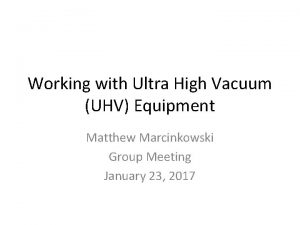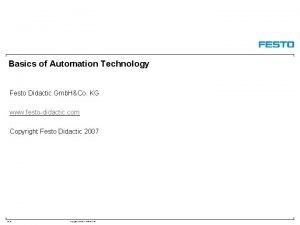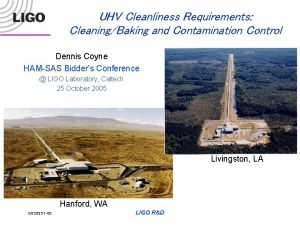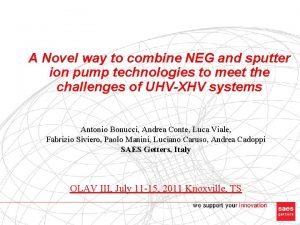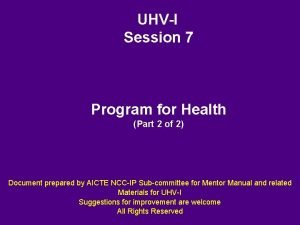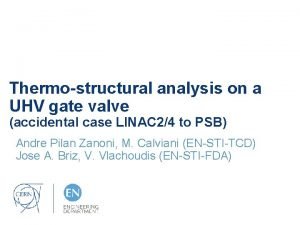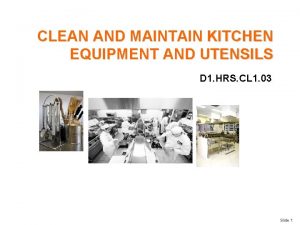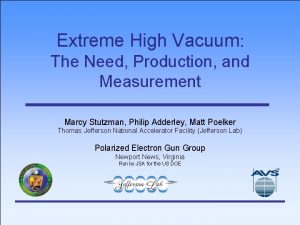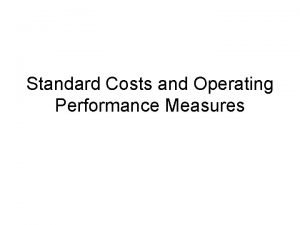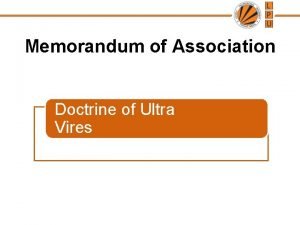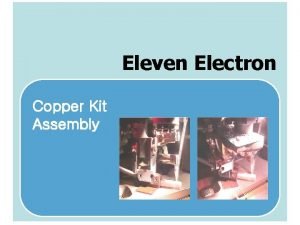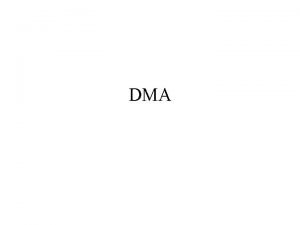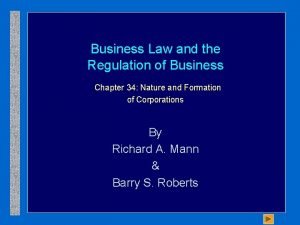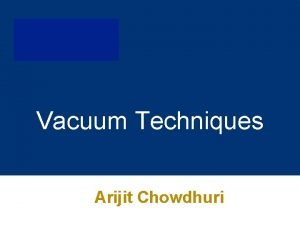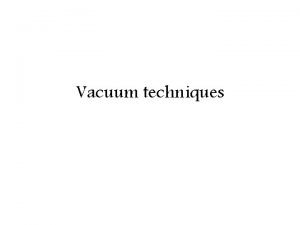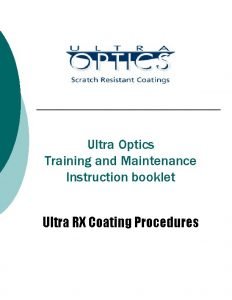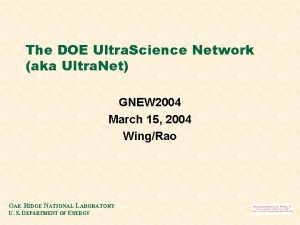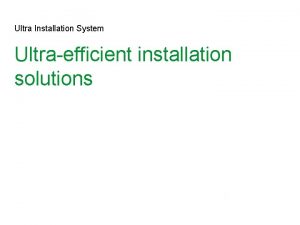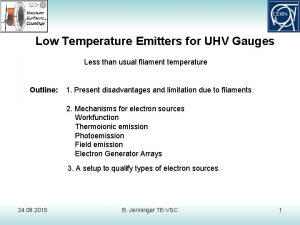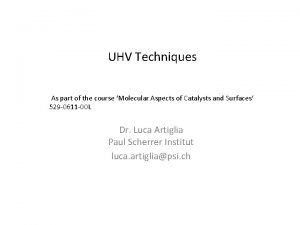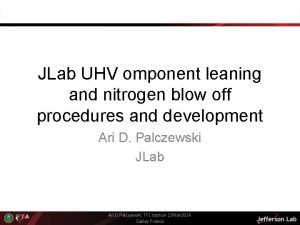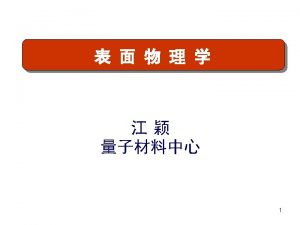Working with Ultra High Vacuum UHV Equipment Matthew


































- Slides: 34

Working with Ultra High Vacuum (UHV) Equipment Matthew Marcinkowski Group Meeting January 23, 2017

Sykes Lab UHV Instruments LT-STM 3 TPD Chambers VT-STM

Outline • Installation • Pumping Down • Bakeouts • Experiments • Venting

Outline • Installation • Pumping Down • Bakeouts • Experiments • Venting

Installation-Cleanliness Wear gloves! Use clean tools. Work on clean aluminum foil. Cover any chamber openings with foil and red plastic covers. Finger prints outgas at the rate of 1 X 10 -5 Torr Liters per second! Leaving finger prints on UHV components may prevent the chamber from pumping to a low enough pressure. The same goes for anything else that may leave oil on a UHV component.

Installation-Materials Selection • Materials for use in UHV need to have a low rate of outgassing.

Installation-Materials Selection • Materials for use in UHV need to have a low rate of outgassing.

Installation-Materials Selection • Materials for use in UHV need to have a low rate of outgassing.

Installation-Conflat Flanges

Installation- Take Care of the Instrument! • Take extra care when handling fragile components! • Knife Edges • Bellows • Feedthroughs • Wobblestick! • Small parts including such as sputter gun components.

Outline • Installation • Pumping Down • Bakeouts • Experiments • Venting

Pumping Down • Procedure is slightly different for each instrument. • It is important to follow procedure to avoid damaging pumps, valves, or other equipment on instrument. • Generally pumping down involves turning on pumps and opening valves in correct order. Rotary pump brings you to rough vacuum. Monitor this stage with a pirani gauge. Turbo Pump Brings you to High Vacuum Regime (Pre-Bake) Monitor the pump down from the high vacuum regime with an ion gauge

Pumping Down-Gas Loads

Pumping Down-Curve

Leak Testing- Rate of Rise • Shut vacuum chamber off from all pumps and monitor the rise in pressure. • Helps to identify if a leak is present.

Leak Testing- Residual Gas Analyzer (RGA) Turbo pumped chamber not baked. Turbo pumped with a leak.

Contaminants- RGA Chamber contaminated by hydrocarbons.

Leak Testing- Methanol Leak Test • Useful for detecting large leaks (Pressure isn’t going below 1 X 10 -6 mbar). • Squirt methanol onto suspect flanges. • If there is a large leak methanol will be sucked into the chamber and the pressure will increase.

Leak Testing- He Leak Test • Can detect much smaller leaks. • Spray helium gas onto suspect flanges (helium is lighter than air, start high end low). • Using an RGA monitor mass 4. • When a flange with a leak is exposed to the gas the RGA signal will increase. • Often RGAs have a leak detection mode with audio cues.

Test Equipment after Pump Down • Before baking it is best to make sure everything you installed or was previously on the instrument is working/still working. • Not everything can be fully tested before a bake, but it is best to test anything that can be. • Sputter gun! • Sample heaters, thermocouples • Mass Specs • Electrical connections on TSP, EFMS, ect.

Outline • Installation • Pumping Down • Bakeouts • Experiments • Venting

Bakeout • Eventually you can reach UHV by pumping overtime with a turbo pump, but baking significantly speeds up the process.

To Prepare for a Bakeout • Remove all non-bakeable items from the chamber • Plastics • Electronics • Magnets • Sample tubes • Anything on the instrument table • Blow out any water lines • Pump behind leak valves • Wrap any fragile components in foil. This will allow these parts to heat up more gradually and not undergo as much strain from heating. • Windex the chamber • Attach heaters and thermocouples to the chamber • Have someone else check your work!

During a bakeout • Ensure you have performed all steps on the previous slide including having someone else check your work! • Cover the chamber using the appropriate bakeout apparatus. • Turn on heaters. • Closely monitor temperature and pressure. Too high of a temperature can damage components (we typically do not go above 120 °C) and if they pressure is too high this may indicate a leak that was missed. • Pressure should initially increase as species are outgassed and then decrease as bake continues. Bake at least 36 hours or until pressure decrease levels off.

Post Bakeout • Ensure heaters are turned off and remove bakeout apparatus. • Replace non-bakeable components • Test all components post bakeout. • Your pressure may still not be below 10 -9 , but that’s ok. You still need to • Degas any filaments or relevant components (MS, EFMs, IG, TSPs, ect). Filaments tend to adsorb gases very strongly and need to be locally heated to temperatures higher than that achieved in a bakeout. • Start using additional pumps post bake to further improve the pressure (TSPs, Ion Pumps, Cryopumping).

Post Bakeout-RGA

Outline • Installation • Pumping Down • Bakeouts • Experiments • Venting

Performing Experiments- Safety • Be safe! First and foremost for yourself and also for the chamber. • • • Wear gloves, eye protection when handling chemicals including cryogens. Be mindful of high voltage components Take appropriate pre-cautions when handling hazardous gases (CO, H 2 especially). Treat components of the UHV system with care especially fragile ones. (Manipulators, any moving parts especially wobblesticks!, feedthroughs, bellows, scanners in STMS!, Mass Specs, XPS, basically any expensive component ect. ) Always keep an eye on the chamber pressure. In the STM chambers be mindful of when you should be using the ion pumps or the turbo pump. Do not attempt any maintenance when the system is at cyrogenic temperatures. Do not flash the TSPs when the chamber is at crygogenic temperatures. In TPD chambers especially flashing TSPs at the end or beginning of the day can help to keep your pressures low. In general think and come up with a plan before you do something to ensure you won’t hurt yourself or break something in the chamber!

Performing Experiments-Records • While you are performing experiments you should be updating the lab notebook as you work. The notebook should at least be updated when you finish with the instrument for the day. • Do not take the notebooks out of the building. Make copies if you need to look at your notes at home. • Make sure to save your data as you work. • Data should be backed up frequently on the N: Drive in the folder for the appropriate instrument in the Data folder.

Typical Procedure for UHV Experiments • Clean sample with Ar+ sputtering. This removes gases adsorbed from the background or contaminants from previous experiments. • Make any modifications to the sample if applicable (metal deposition, form an oxide ect. ) • Dose molecule of interest if applicable. • Perform measurement (TPD, STM, XPS, IR, ect). • If the sample is unchanged by the molecule or measurement continue to perform doses and measurements. Otherwise repeat from the beginning.

How do Power Outages Affect Experiments? • The TPD 1 and 2 are on Uninterrupted Power Supplies (UPSs) which are further plugged into the backup generator. • If power is lost to your chamber each instrument has a procedure for safely pumping the instrument back down. It is important to follow the appropriate sequence of events and not allow a pump or valve to open too early. • Be wary of potential pressure differentials when reopening valves and turning on pumps. • If there is a planned power outage it is often better to shut down the equipment in a controlled manner rather than let the power trip everything off.

Outline • Installation • Pumping Down • Bakeouts • Experiments • Venting

Venting While a vacuum chamber usually becomes unavoidable at some point, it should not be done without good reason. It is very easy for equipment to break during vents and the subsequent pump downs and bakeouts. • Venting is often necessary when a require component stops working (ie sputter gun, thermocouples on TPD, ect). • Venting is sometimes necessary to install new components. • Vents can sometimes be avoided by over pressurizing with Ar. • Think about experiments you can do without the broken or new component before venting. For example if your EFM for metal evaporation stops working are there experiments you can do on the pure crystal surface before venting? • Vents can sometimes be planned around planned power outages.

Venting-Procedure Again, this is different from instrument to instrument but the following general procedure can be applied to each instrument. 1. Turn off all components that should not be exposed to high pressures such as ion gauges. 2. Seal the chamber off from all pumps using valves or by shutting off ion pumps. 3. Shut down remaining pumps in a controlled manner. For example shut off the turbo pump in the TPDs before turning off the backing rotary. 4. Vent any backing lines to air. 5. There is a vent valve somewhere on each chamber. Attach plastic tubing to this valve and insert it into a dewar filled with LN 2. Slowly open the vent valve to vent the chamber to N 2 gas. This limits the exposure of the chamber to air. 6. Once the chamber and backing line is vented you can begin to perform maintainance/ install new components.
 Uhv aluminum foil
Uhv aluminum foil Hco
Hco Uhv aluminum foil
Uhv aluminum foil Tools for uhv surface science
Tools for uhv surface science Balanced scorecards
Balanced scorecards Uhv
Uhv Uhv and xhv ion pump 40 l/s
Uhv and xhv ion pump 40 l/s Uhv session
Uhv session Uhv gate valve
Uhv gate valve Insulation coordination in high voltage engineering
Insulation coordination in high voltage engineering Acn high speed internet
Acn high speed internet Cleaning and maintaining kitchen premises
Cleaning and maintaining kitchen premises Smart work and hard work
Smart work and hard work Advantage of hot working
Advantage of hot working Hot working and cold working difference
Hot working and cold working difference Differentiate between hot working and cold working
Differentiate between hot working and cold working Prinsip dasar proses pengerjaan panas yang benar adalah
Prinsip dasar proses pengerjaan panas yang benar adalah Extreme high vacuum
Extreme high vacuum Longwood high school working papers
Longwood high school working papers Nemo ultra posse obligatur
Nemo ultra posse obligatur True-tone ab-700 model ultra glide
True-tone ab-700 model ultra glide The watsons go to birmingham brown bomber car
The watsons go to birmingham brown bomber car Tt ab-700
Tt ab-700 Planning and operational variances
Planning and operational variances Ultra prefix examples
Ultra prefix examples Ultra vires meaning
Ultra vires meaning Jeffrey prinzie
Jeffrey prinzie Medium scale integrated circuit
Medium scale integrated circuit Ultra reiz akım
Ultra reiz akım K&s maxum ultra
K&s maxum ultra Sata transfer mode
Sata transfer mode Bullington v. palangio
Bullington v. palangio Ultra vires acts of corporation
Ultra vires acts of corporation Analisis swot ultra milk
Analisis swot ultra milk Tim koleti
Tim koleti
